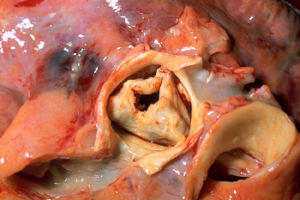Indications For Aortic Valve Replacement Due To Aortic Stenosis
Written By: Adam Pick, Patient Advocate, Author & Website Founder
Page Last Updated: May 11, 2025
David just wrote me an email that reads, “Hi Adam – I’m really confused right now. My doctor says I have severe aortic stenosis which could require heart valve replacement. Strange part? I feel fine. Can you help me better understand what are the key indicators for aortic valve replacement?”
Many patients believe that symptoms are the key indicators for valve operations. However, as I and others can attest, patients can be asymptomatic and still be very ill. That said, the key indicator for valve replacement due to aortic stenosis deals with the size of the heart valve and the rate of blood through the valve.

Example Of Aortic Valve With Severe Stenosis
According to Dr. William Gaasch, MD, “Individuals with normal aortic valves have valve area is 3.0 to 4.0 cm2. As aortic stenosis develops, a minimal aortic valve gradient is present until the orifice area falls by more than 50 percent. In general, symptoms in patients with aortic stenosis and normal left ventricular systolic function rarely occur until the valve area is less than 1.0 cm2, the aortic jet velocity is over 4.0 m/sec, and/or the mean transvalvular gradient exceeds 40 mmHg.”
This is one of the key indicators for aortic valve replacement. As Dr. Gaasch further notes, “Surgical replacement of the aortic valve is the only effective treatment for severe aortic stenosis. Although there is some lack of agreement about the optimal timing of surgery, it is still possible to develop rational guidelines for the evaluation and management of most patients.
I hope this helps David and you better understand that patient symptoms are not the best indicators for aortic valve surgery due to stenosis. Rather, effective valve measurement through patient echocardiograms appear more appropriate.
Related Link:
Keep on tickin!
Adam
|
nancy mallinger says on November 3rd, 2008 at 6:42 pm |
|
I have been diagnosed with severe aortic stenosis (.4-.6 cm2) and have no symptoms. But every doctor that I have seen (and there have been quite a few) insists that I have a replacement now. I have surgery set for Tuesday, but I’m having a very hard time wrapping my head around the fact that I’m having this incredibly big surgery when I feel fine and have not noticed any decline in my stamina, etc. I was always of the “if it ain’t broke, don’t fix it” school. |
 |
|
Carol Lang says on November 4th, 2008 at 1:24 am |
|
I feel compelled to share my experience on this issue. I am a former ICU nurse that had a mechanical AVR this past June. My cardiologist had been monitoring me very closely for the past 14 years. When he told me my echo had progressed to severe AS, & it was time for a cath & surgery, I was shocked! I asked how this could be possible, as I had no symptoms & had never looked or felt better in my life. (I am nearly 5 years post gastric bypass surgery & have lost nearly 100 lbs) |
 |











